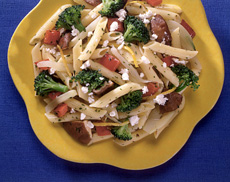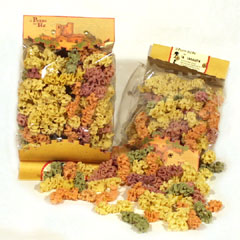

This penne recipe was the Grand Prize Winner in a national competition among professional chefs sponsored by the National Pasta Association at the Culinary Institute of America. You can click on the article below for the recipe. Photo courtesy National Pasta Association.
|
 |

Gourmet Pasta, Pizza & Pasta Sauce
Plus Gourmet Pasta & Pizza Recipes
Click here to jump down to the articles, reviews and recipes
A Brief History Of Pasta
Pasta, the Italian word for noodles, probably originated in central Asia. The Chinese were eating “a noodle-like food” as early as 3000 B.C. To debunk popular belief, pasta did not come to Italy with Marco Polo: A listing of pasta exists in an Italian estate record of 1275, 20 years prior to Polo’s China visit. While Polo may have brought back pasta, and the overall publicity of his travels no doubt publicized pasta and his other “discoveries” throughout Europe, he was hardly the first Italian to enjoy it.
More likely, pasta first traveled from China to the Holy Land* and introduced to Italy by the Arabs during their conquest of Sicily in the Fifth Century C.E. Dried pasta was carried by the invaders as an easily-prepared staple. The Arab geographer Al Idrisi wrote that a flour-based product in the shape of strings (i.e., spaghetti, which means cords or strings in Italian) was produced in Palermo, then an Arab colony.
*The first written record of boiled noodles is in the Jerusalem Talmud, written in the 5th century C.E., referring to dried noodles purchased from a vendor. Perhaps 1,000 years earlier, the ancient Greeks and later the Romans had broad, flat strips of dough called laganon, but they were roasted, not boiled—more like pizza strips and pie dough.
Thomas Jefferson discovered the charms of pasta when, as minister to France from 1784 to 1789, he traveled to Italy. He not only brought what is believed to be the first pasta machine to America, but proceeded to invent a machine of his own (and then invented macaroni and cheese). However, what happened in the dining rooms of the elite did not quickly migrate to the average household kitchen; and it took the broadscale Italian immigration in the late 19th and early 20th centuries, for pasta to begin to become one of America’s most popular comfort foods.
Pasta Today
According to The American Pasta Report, commissioned by the National Pasta Association, 75% of Americans eat pasta on a weekly basis. (84% if you live in the Northeast). “Pasta” is hardly a generic term: Just as the quality of sauce varies widely, so does the quality of pasta. Top-quality pasta is so flavorful in of itself, it can be enjoyed with only a dab of olive oil or butter and some grated cheese—which is exactly how it is enjoyed in Italy.
While American and Italian pastas are made from durum wheat (semolina is the ground wheat kernel of durum), pasta can be made from other flours. Some northern European countries use other wheats or potatoes. Asian noodles, also called threads, can be made of rice, soybean, wheat, or other flours. The “glass noodles” used in Thai dishes are made from soybean flour, the opaque white Chinese noodles from rice flour, and Japanese soba noodles from buckwheat flour. Polish pierogi, Italian gnocchi and German spaetzle, which are generally referred to as dumplings, are also considered forms of pasta.
For an Italian-style pasta dish, be sure to buy a semolina-based pasta: It has the gluten level to achieve an al dente texture and the stickiness that allows sauce to adhere to the pasta.
There’s more information about buying and cooking pasta below.
- If you have suggestions, or comments, use the Contact Us link on this page.
- Find more pasta information on Blog.TheNibble.com.
| Gourmet Pasta & Pizza Reviews |
Gourmet Pasta Sauce Reviews & More |
|
|
|
| Pasta Information Articles |
Gourmet Pasta & Pizza Recipes (Continued) |
| Gourmet Pasta & Pizza Recipes |
Pasta Recipes
|
Pizza Recipes
Macaroni & Noodle Recipes
Pasta Sauce Recipes
Dessert Pasta Recipes
|
Nibble Tip
Tuck away a bag or two of gorgeous shaped and colored pasta by Tradizioni di Puglia or Castellano—two brands imported from Italy and available at many specialty food stores (or try some other brands you come across— we like these two because they hold their colors). Keep a container of excellent grated Pecorino Romano or Parmesan in the freezer—it keeps well in an airtight container. And, slice some gourmet sausages (like Bilinski) and keep them in the freezer, microwave-ready in 40 seconds.
|

Capricci Tricolore Pasta by Pastificio Pozzo del
Re. Read our review. |
When you need an impressive impromptu dinner invitation, just mix the three together and serve with a salad. You don’t even need a formal sauce—if you don’t have any at hand, butter or olive oil and some cracked pepper is just perfect. |

|
|



